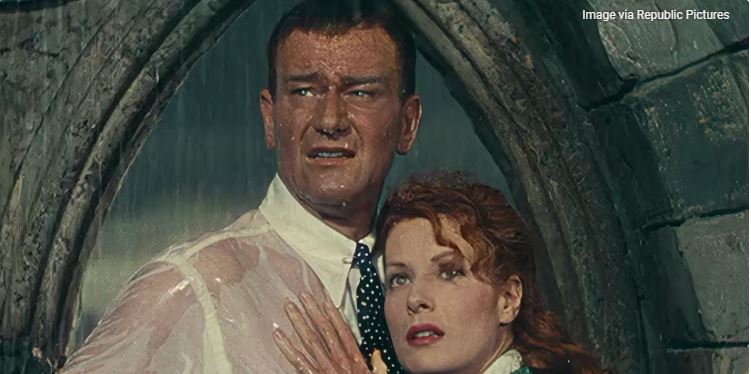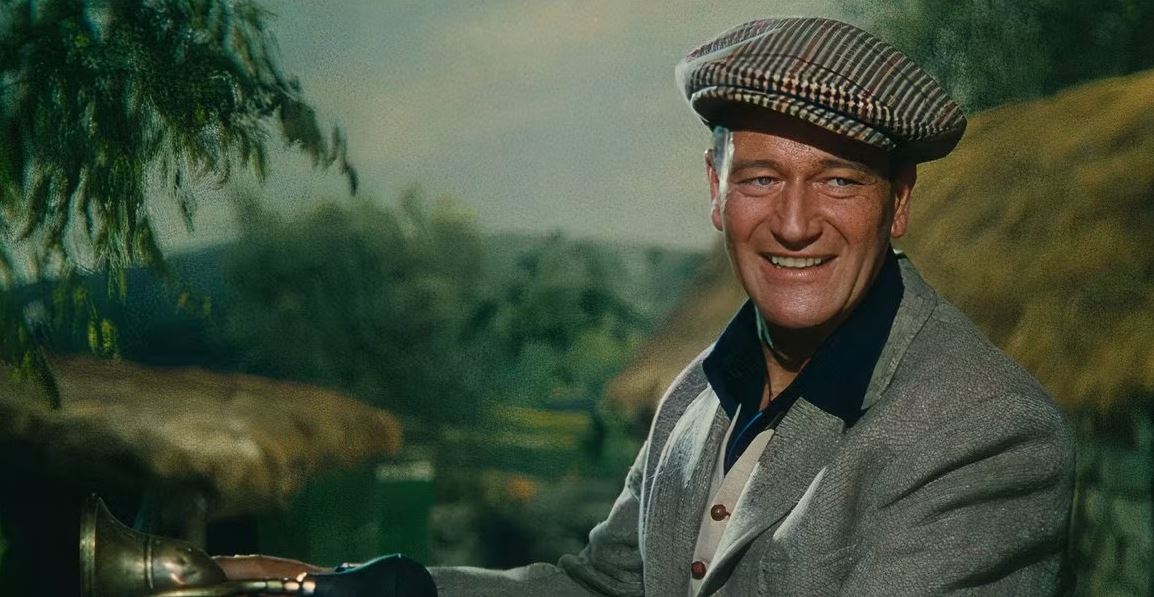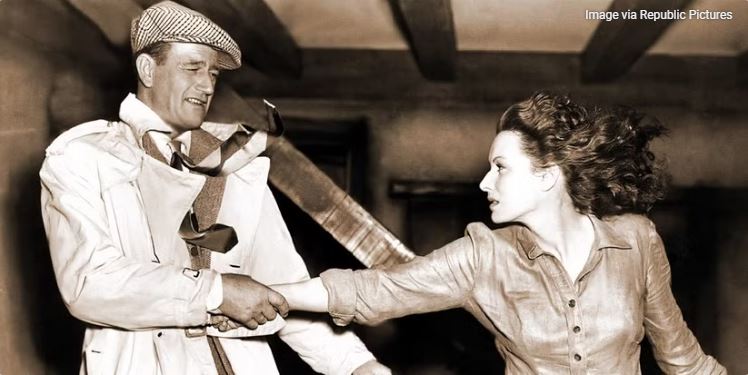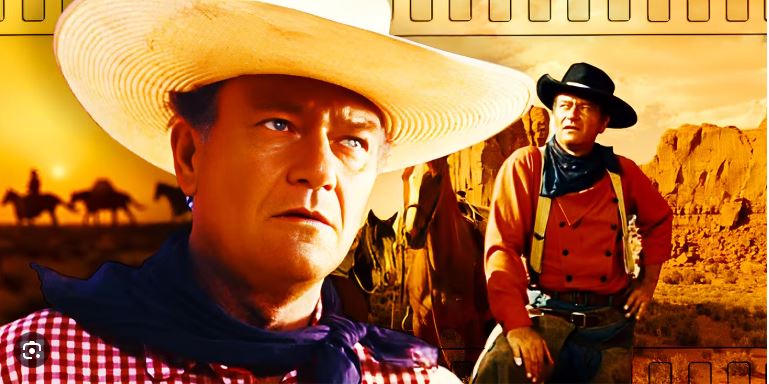1952’s The Quiet Man was a bit of a departure for the rough-and-tumble John Wayne. Known for his tough-guy image and iconic Westerns by the 1950s, a romantic comedy/drama was not exactly what audiences expected from The Duke. Based on a 1933 short story of the same name, the movie showcased beautiful, sweeping views of Ireland. It was a love letter to the country itself and a disappearing way of life in the Irish countryside. Although it would certainly be viewed differently by many through a modern lens, it still has a sort of nostalgic charm for audiences who grew up with it.
This would be the second movie to star Wayne and costar Maureen O’Hara, who would go on to star in two more films together. And their onscreen dynamic sizzles as much as it amuses. Ultimately, The Quiet Man is certainly a product of its time as well as an immortal delight for any fan of Wayne and his versatility as an actor.
The Quiet Man Was a Different Type of Movie for John Wayne

By the 1950s, Wayne had been working in the film industry for over 20 years. And even in his earliest days, he was featured in Westerns such as The Big Trail (1930) and Stagecoach (1939). War movies had also become another common genre for Wayne, appearing in Sands of Iwo Jima (1949) and Operation Pacific (1951). And while playing a romantic lead in movies like Angel and the Bad Man (1947) and working on comedies like Without Reservations (1946) didn’t place The Quiet Man quite outside Wayne’s wheelhouse, it was a unique film for him. It was a project Wayne personally believed in. Wayne even lured long-time collaborator John Ford over to Republic Pictures to direct the movie, earning Ford an Oscar for Best Director.
Securing the rights to The Quiet Man was a fairly simple process. According to Maureen O’Hara’s 2005 autobiography ‘Tis Herself, Ford had read the original short story when it was first published and bought the rights for $10. When Ford moved to Republic to direct the picture, author Maurice Walsh was paid an additional $2,500 and received a final $3,750 when the movie was finally made. Even then, Republic only gave the green light for The Quiet Man after Ford, O’Hara, and Wayne all agreed to do an additional Western together. Upon completing Rio Grande (1950), they were able to begin filming The Quiet Man. Despite the latter being the picture that would prove more successful in the long run, Wayne’s Westerns were still considered the more bankable movies at the time.
Republic’s faith in The Quiet Man was expressed in more ways than one. Initially, the studio stipulated that the movie had to be under two hours in length. However, Ford found his own way of convincing the studios that the movie needed more time to cook. During initial screenings with executives, Ford would cut the movie off at exactly the two-hour mark, moments before the now-infamous fist fight between Squire Will Danaher (Victor McLaglen) and Sean Thornton (Wayne). The executives were so enthralled with the film by this stage that they relented and allowed the movie to keep its unapproved runtime. It truly ended up being a piece of cinema that spoke for itself when it came to quality storytelling.
Ford would not be the only Academy Award nod for The Quiet Man. It was nominated for seven Oscars in total, winning two of them: Ford for Best Director and Winton C. Hoch and Archie Stout for Best Cinematography – Color. Critics also praised the film. A.H. Weiler of the New York Times called it “as darlin’ a picture as we’ve seen this year.” Harrison’s Reports described it as “a delightful and rollicking comedy melodrama of Irish life, directed with skill and acted with gusto by a fine cast.” Kay Proctor of the Los Angeles Examiner said it best when it came to Wayne’s performance:
No surprise is John Wayne’s excellence…As always under Ford’s tutelage, he’s plain great. What is unexpected is the flair for comedy he demonstrates here…Never before, I’m sure, have you seen a movie quite like this one, nor will you again, unless you go see it twice or more.
Wayne was able to show audiences his versatility and sentimentality in The Quiet Man, and it led to one of his most effective performances in a totally unexpected film.
The Quiet Man Was Filmed on Location in Ireland

One of the most special elements of The Quiet Man is its authenticity and loyalty to its setting: Ireland. The movie was filmed on-location in a series of places in County Mayo and County Galway. Many of the key scenes were filmed in the village of Cong, which, to this day, still enjoys its claim to fame for The Quiet Man. This definitely added to the movie’s budget at the time and made it even more of a gamble for Republic Pictures. For the film, the fictional village of Inisfree was created. The town became a place that Wayne’s character, Sean Thornton, was returning to as an adult after living in America following his early childhood on the Emerald Isle. He’s welcomed back to the town with open arms and soon falls in love with a local “spinster,” Mary Kate Danaher (O’Hara), sister of Squire Danaher.
Outside of O’Hara herself, who hailed from Dublin, the movie boasted other Irish luminaries. Actor Barry Fitzgerald played Michaeleen “Óge” Flynn, the local matchmaker. Known for both his dramatic and comedic performances, Fitzgerald was an Irish actor of stage, screen, film, and television. Although in The Quiet Man, he was most certainly showcasing his comedic chops to great effect and served as a great foil for characters like Squire Danaher. Fitzgerald’s real-life brother, Arthur Shields, also featured in the film. Shields played Reverend Cyril Playfair, a Protestant minister who is under threat of being relocated should he not gain a large enough following in the village.
Despite the rolling hills and sweeping views of Ireland, only two weeks of production was spent in the country. According to TCM.com, the local hotels could not accommodate the American cast and crew. In fact, if audiences were to visit Cong today, they would find a 5-star hotel, Ashford Castle, that features in silhouette in the opening credits of The Quiet Man.
A bridge leading up to the castle also featured in a scene where Michaeleen drives Mary Kate and Sean across it near Father Lonergan’s (Ward Bond) fishing spot. The pub featured in the film was actually a grocery store at the time, and only since the early 2000s has it been converted into a true pub, as in the movie. Although everything seems fairly close in the movie, any tourists attempting to sight-see all the filming locations would most certainly need a vehicle to do so — the production covered a lot of ground in the two weeks it had.
John Wayne’s The Quiet Man Is Problematic but Still Enjoyable

At the heart of The Quiet Man is a love story between two kindred spirits. Still, to a modern eye, it might have controversial elements. Specifically, Sean and Mary Kate’s very physical relationship. The two tend to push each other around a great deal in the film, and it all culminates in a dragged-out scene with Sean literally throwing her at the feet of her brother, Squire Danager, in a public attempt to end their marriage. Sean, a man who refuses to fight due to his accidental killing of a man in his career as a professional boxer, declines to fight her brother up until this point in order to reclaim her dowry. The culture clash between Mary Kate’s desire for her dowry and Sean American sensibilities that none of it matters is at the heart of the conflict.
If viewers simply analyze the movie on a surface level, there is a lot that could be labeled problematic when it comes to the roughing around that was played for laughs. But at the heart of it is a fairly modern message. Critic Molly Haskell remarked, “In characteristic American fashion, [Sean felt] his masculinity and ability to provide for her impugned, until she finally makes him understand that it is not the money but what it stands for. The dowry and furniture are her identity, her independence.”
Mary Kate stopped at nothing to stand up for herself and, as TCM.com points out: “she’s never pictured as a horrible shrew.” This might have been as modern and feminist as a movie might dare to go in 1952. Sure, that might be an unconventional view to take of The Quiet Man in the present day, but it’s also possible to accept that some films are simply of their time and still enjoy and appreciate them. And there is still much to appreciate about The Quiet Man. Modern audiences still seem to overwhelmingly agree. After all, there must still be a reason Wayne’s pet project still holds strong at a 91% on Rotten Tomatoes from both critics and audiences alike.
